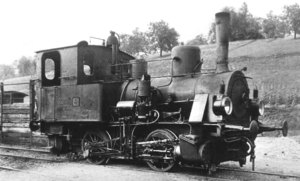V&W 1-9
| V&W 1-9 | |
|---|---|
|
Locomotive 2 of the Kandertal Railway, around 1937
|
|
| Numbering: |
KMS 1–2 HK 1–2 VDD 1–2 DWE 1–3 DEBG 1–5 |
| Number: | 9 |
| Manufacturer: |
Henschel , Kassel serial numbers 3997–3999, 4077–4080, 4423, 4424 |
| Year of construction (s): | 1894-1895 |
| Retirement: | until the late 1950s |
| Type : | B n2t |
| Gauge : | 1435 mm ( standard gauge ) |
| Length over buffers: | 6,850 mm |
| Total wheelbase: | 2,100 mm |
| Empty mass: | 14.92 t |
| Service mass: | 20.5 t |
| Friction mass: | 20.5 t |
| Wheel set mass : | 10.25 t |
| Top speed: | 40 km / h |
| Indexed performance : | 88.3 kW (120 PS) |
| Driving wheel diameter: | 1,020 mm |
| Control type : | Allan |
| Cylinder diameter: | 275 mm |
| Piston stroke: | 450 mm |
| Boiler overpressure: | 12 bar |
| Number of heating pipes: | 91 |
| Heating pipe length: | 2,700 mm |
| Grate area: | 0.73 m² |
| Evaporation heating surface: | 38.607 m² |
| Water supply: | 2.5 m³ |
| Fuel supply: | 0.7 t |
| Brake: | originally Körting suction air brake u. Handbrake after modification of compressed air brake type Knorr |
The standard-gauge steam locomotives V&W 1-9 were built by the Henschel locomotive factory in Kassel for Vering & Waechter and used by various railways of the operating company.
They were later replaced by more powerful machines. Five locomotives were used by the Deutsche Eisenbahn-Betriebsgesellschaft , these locomotives remained in service until the late 1950s. No vehicle has survived.
History and commitment
The Henschel locomotive factory in Kassel delivered a total of nine identical locomotives for Vering & Waechter in 1894/1895 with a service weight of around 20 t and 120 hp as initial equipment for the Münstertal Railway , Kandertal Railway , Kleinbahn Voldagsen-Duingen-Delligsen and Dessau-Wörlitzer Railway . The locomotives could be acquired on good terms.
The small locomotives were soon no longer able to cope with the increase in traffic. As they mainly traveled on excursion trains, the smoke nuisance was a problem. However, the attempts to reduce the smoke nuisance were unsuccessful and were discontinued. For these reasons, the locomotives should be replaced soon after the First World War .
Dessau – Wörlitz Railway Company
The locomotives with the serial numbers 3997 to 3999 came to the Dessau – Wörlitzer Railway Company in 1894. One of the two led the opening train there, which consisted of only three cars. The machines achieved a mileage of 63,040 km each in the 1894/1895 financial year.
The locomotives were soon replaced by the more powerful Henschel Prussia or Prussian T 3 locomotives . There was no planned sale after the First World War. The first locomotive was taken out of service in 1923, and all of them were out of service by 1936.
German Railway Operating Company
The low performance of the locomotives of the Deutsche-Eisenbahn-Betriebs-Gesellschaft soon had a negative impact, so that the aim was to sell the vehicles. This was achieved with the VDD 1 used on the Voldagsen – Delligsen railway line , which was sold to a mining company in 1911/12.
The other machines were taken over by DEBG and were named 1 to 5 there . The former KMS 1 locomotive retired from operation in 1939. The former VDD 2 and KMS 2 locomotives were rented to the Rhein-Ettenheimmünster local railway in the 1920s and were in use until the mid-1950s. Then they were retired and scrapped.
The two locomotives of the Kandertalbahn were handed over to the Münstertalbahn from the 1930s , where they were used until the 1950s. The former HK 1 , which was not taken out of service until October 1959, has been around for the longest time.
technology
The locomotives had an inner frame with a water tank riveted into the frame cheeks. On both sides of the boiler there was a smaller external water tank on the right and a coal tank for 0.7 t coal on the left in front of the driver's cab. The iron kettle had a copper firebox . The wrought-iron spoked wheels were cushioned above the circumference with leaf springs. The locomotives had a relatively long and narrow chimney.
The Allan valve had flat slide diagonally on the steam cylinders. In front of the driver's cab was the Ramsbotton type safety valve and a cylindrical sandpit with a sand downpipe in front of the rear drive wheel. There was also a steam dome, a Latowski bell on the driver's cab and a regular pulling and buffing device . Originally the locomotives had a suction air brake type Körting and a hand brake, after the First World War they were converted to air brakes . The large kerosene lighting lanterns were converted to electric lighting with a turbo generator around 1939 .
literature
- August Villinger / Ludger Kenning: The Münstertal Railway . Kenning Verlag, Nordhorn 2016, ISBN 978-3-933613-54-7 , pp. 74-78 .
- Ludger Kenning: The Dessau-Wörlitz Railway . Kenning Verlag, Nordhorn 2014, ISBN 978-3-944390-05-5 , pp. 24-28 .
- Meinhard Döpner: The Deutsche Eisenbahn-Betriebs-Gesellschaft AG . Lokrundschau Verlag GmbH, Gülzow 2002, ISBN 3-931647-13-7 , p. 128 .
Individual evidence
- ^ A b c Ludger Kenning: The Dessau-Wörlitzer Railway . Kenning Verlag, Nordhorn 2014, ISBN 978-3-944390-05-5 , pp. 24 .
- ^ Ludger Kenning: The Dessau-Wörlitzer Railway . Kenning Verlag, Nordhorn 2014, ISBN 978-3-944390-05-5 , pp. 9 .
- ↑ Data sheet about the vehicles of the Kleinbahn Voldagsen-Duingen-Delligsen with mention of the locomotive 1
- ↑ a b c d August Villinger / Ludger Kenning: The Münstertal Railway . Kenning Verlag, Nordhorn 2016, ISBN 978-3-933613-54-7 , pp. 74-78 .
